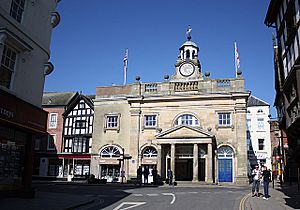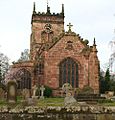William Baker of Audlem facts for kids
Quick facts for kids
William Baker
|
|
|---|---|

The Buttercross, Broad Street, Ludlow 1743-4
|
|
| Born | 1705 London
|
| Died | 1771 Audlem, Cheshire
|
| Nationality | British |
| Alma mater | Possibly a pupil of Francis Smith of Warwick |
| Occupation | Architect |
| Buildings | Montgomery Town Hall, The Buttermarket Ludlow, |
William Baker of Audlem (1705–1771) was a talented British architect, surveyor, and builder. He worked in the middle of the 18th century, mainly in Shropshire and the areas nearby. He designed many important buildings, including town halls and churches.
Contents
Early Life and Family
William Baker was born in London in 1705. His father, Richard Baker, later moved the family to Ludlow. In 1737, William married Jane Dod from Audlem. For a while, they lived in Bridgnorth. Later, in the 1740s, his wife inherited Highfields House, and they moved to Audlem, a village in Cheshire.
William Baker's Career
William Baker learned his skills by working for a famous architect named Francis Smith of Warwick in the 1730s. He even worked as a carpenter for Smith at a place called Ditchley in 1727.
Around 1740, William Baker started his own business. He didn't just design buildings; he also managed their construction and surveyed land. He became very busy in eastern Shropshire and Staffordshire. After Francis Smith died in 1738, William Baker took over many of his projects. He continued work on large houses like Mawley Hall and Swynerton Hall.
William Baker also worked closely with another architect from Shrewsbury, Thomas Farnolls Pritchard. Sometimes they worked together, and it's thought that Pritchard often helped Baker on his projects.
Designing Important Buildings
William Baker was very good at the popular building styles of his time. He designed many public buildings and churches.
One of his most famous works is the Ludlow Buttercross. In 1743, both Baker and Thomas Pritchard submitted plans for this building in Ludlow. Baker's design was chosen. The Buttercross was a special building that even held the Ludlow Council Chamber. Its design was inspired by a famous book on architecture by James Gibbs.
William Baker also gained the support of Henry Herbert, 1st Earl of Powis, a powerful local leader. Herbert was very impressed with the Buttercross. He hired Baker for several projects, including:
- Making changes to his house at Oakly Park near Ludlow (1748-1758).
- Repairing Powis Castle (1748-1754).
- Designing and building the Montgomery Town Hall (1748). This town hall was important because it hosted the local court, which Herbert oversaw.
Baker also submitted designs for a new Town Hall in Bishops Castle in 1745. This building was completed a bit later with some changes to his original plans.
Richard Baker Continues the Work
William Baker's son, Richard Baker (1743–1803), took over the business after his father passed away in 1771. Richard mostly worked as a building surveyor, which means he measured and checked buildings. He didn't design as many new buildings as his father.
Key Architectural Works
Public Buildings and Monuments
- Bishops Castle, Shropshire: Town Hall (1745–1750).
- Ludlow, Shropshire: The Butter Cross (1743–1744). This building is made of Grinshill stone and has a grand entrance.
- Shrewsbury: Royal Shropshire Infirmary (1747). William Baker was paid for this work, even though the plans were signed by Thomas Farnolls Pritchard.
- Montgomery: The Town Hall (1748–1751).
- Hereford: College of the Vicars Choral (1750). Baker did repairs and changes here.
Churches Designed or Built
- St Peter's Church, Congleton, Cheshire (1740–1742). William Baker built this church for £2,000.
- Stone, Staffordshire: St Michael's Church (1754–1758). This church was designed by William Robinson, but Baker was involved in its construction.
- St John's Church, Wolverhampton (1756–1759). This is a very grand church, similar to James Gibbs' St Martin-in-the-Fields in London. William Baker was the main builder, likely with help from Thomas Farnolls Pritchard.
- Seighford, Staffordshire: St Chad's Church (1757). Baker rebuilt the tower and nave.
- Ellenhall, Staffordshire (1757). Baker estimated £1023 for church repairs.
- St Mary's Church, Acton, near Nantwich, Cheshire (1758). Baker rebuilt much of this church after its tower was damaged.
- St Chad's Church, Wybunbury, Cheshire. Baker helped fix the leaning tower of this church.
- Upper Penn Church, near Wolverhampton (1765). Baker covered the tower in brickwork and added decorative features.
Houses and Estates
William Baker worked on many houses, sometimes designing new parts or making changes.
- Ludlow: 52 Broad Street.
- Wolverhampton: Penn Hall.
- North Claines, Worcestershire: Bevere House (1748–1749).
- Morville Hall, Shropshire: Added two wings.
- Liverpool: Houses in Hanover Street (1748) (now demolished).
- Mawley Hall, Shropshire: Possible work on stables (1748).
- Ranton Abbey Staffordshire: Surveyed (1748–1742).
- Powis Castle Montgomeryshire: Unspecified work (1748–1754).
- Oakly Park, Bromfield: Alterations (1748–1758).
- Enville Staffordshire: "Lady Dorothy's Cottage" (1748–50).
- Morville: Aldenham House, Shropshire: Stable Block (1750–1751).
- Tixall Hall Staffordshire (1750–1751) (now demolished).
- Darlaston Hall, Staffordshire: Plans for a house (now demolished).
- Acton Burnell Hall, Shropshire (1753–1758).
- Wood Eaton, Staffordshire: The Hall Farmhouse (1753–1756).
- Wingerworth Hall, Derbyshire (1753–1754) (now demolished).
- Stoke on Tern, Shropshire: Woodhouse Farm (1754–1758). This is an example of Baker's smaller brick houses.
- Swynnerton Hall, Staffordshire: Outbuildings (1754).
- Patshull House, Staffordshire (1754–1758). Baker finished work started by James Gibbs.
- Hankelow Hall, Cheshire: Alterations (1755–1757).
- Egginton Hall, Derbyshire: Alterations (1755–1757).
- Terrick Hall, Whitchurch: Plan (1756).
- Whitmore Hall, Staffordshire: Survey (1765).
- Brand Hall, Norton in Hales, Shropshire (1756): Minor changes.
- Hanmer Hall, Wrexham: Additional building (1756).
- Astbury Rectory, Cheshire: Alterations (1757–1759).
- Keele Hall, Staffordshire: Alterations (1757–1759).
- Dorfold Hall, Cheshire: Alterations (1757–1759).
- Woodhouse or Wodehouse near Wombourne, Staffordshire: Stable block (1758–1759).
- Sidway Hall near Maer, Staffordshire: Altered or rebuilt (1758–1759).
- Teddesley Hall, Penkridge, Staffordshire: Possible wings (c1759) (now demolished).
Some houses are thought to be by Baker because they look like his other work:
- Burnhill Green Farm Patshull.
- Woore: The Swan Hotel.
- Sibdon Carwood, Shropshire: Sibdon Castle.
Images for kids
Gallery of Architectural Work























